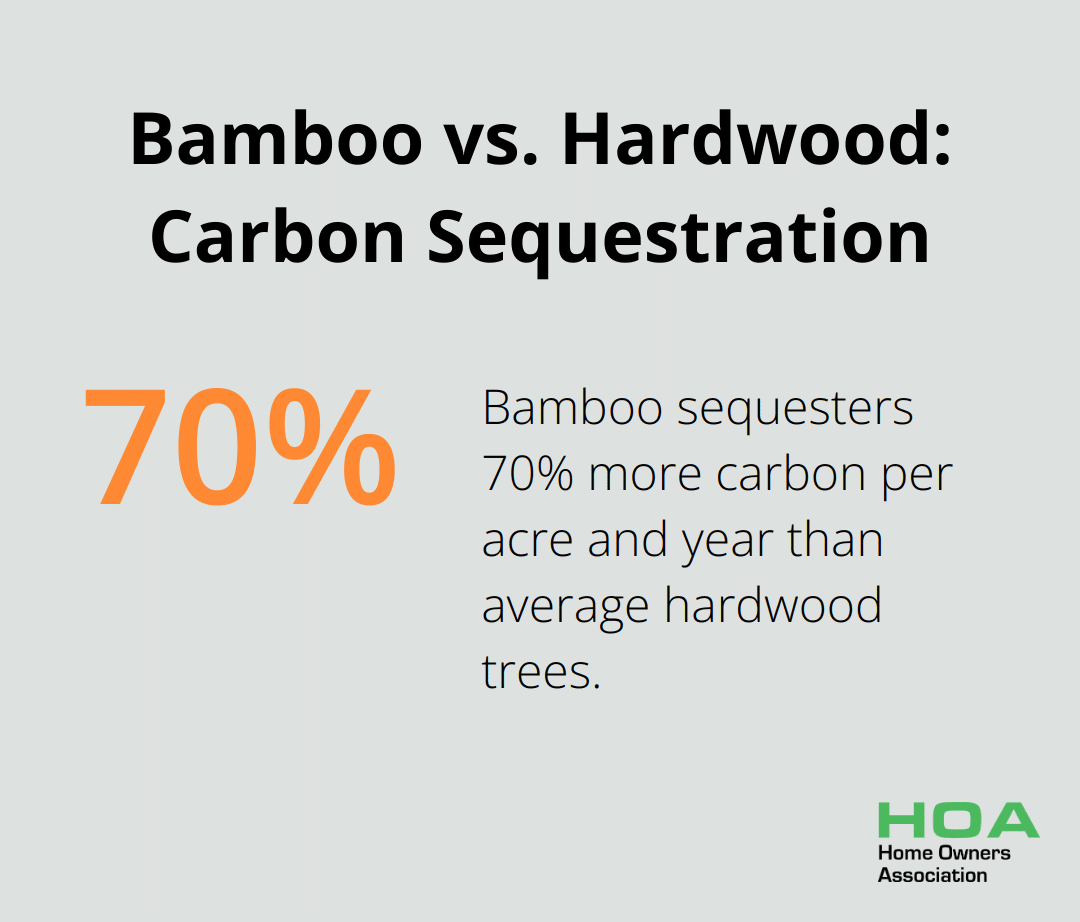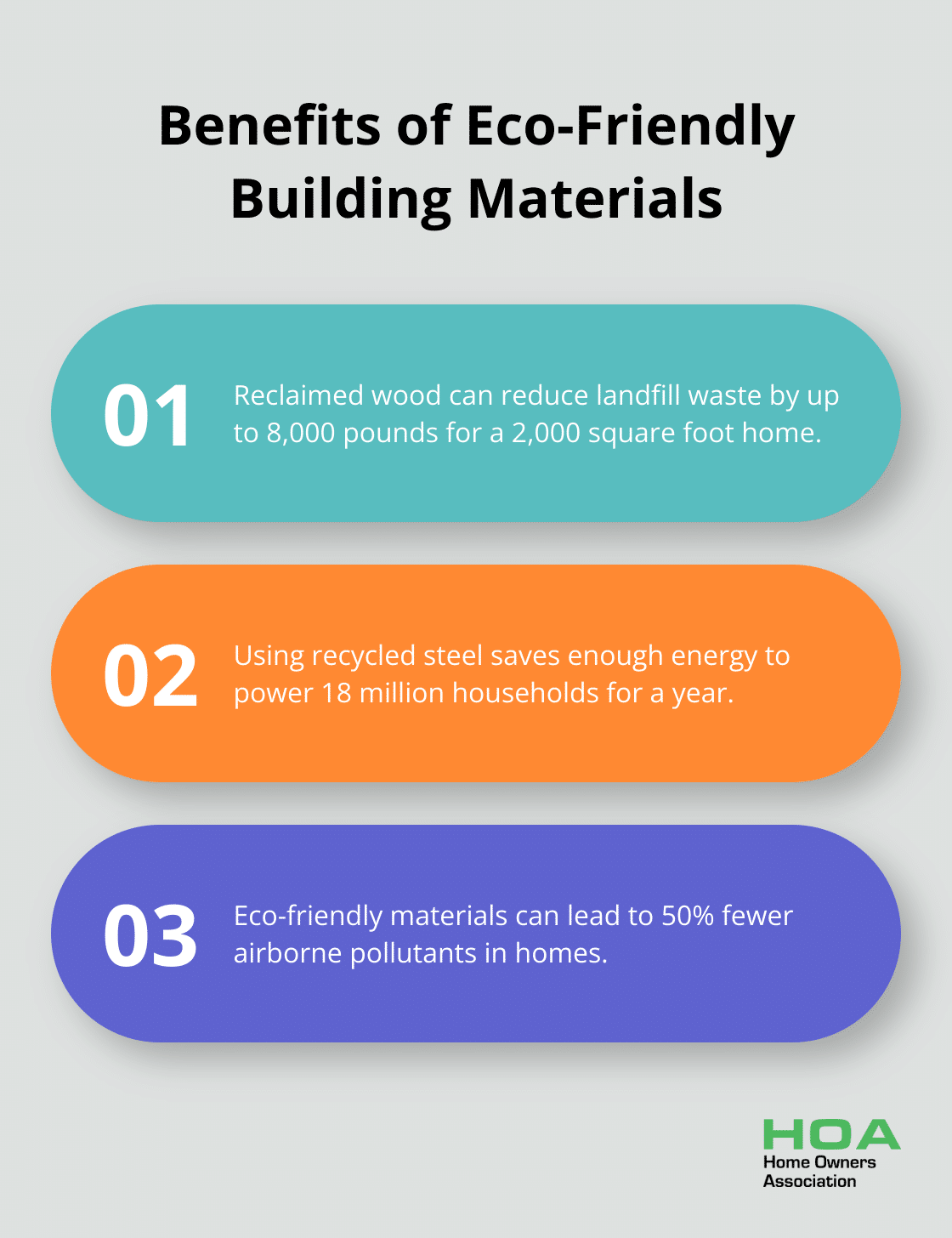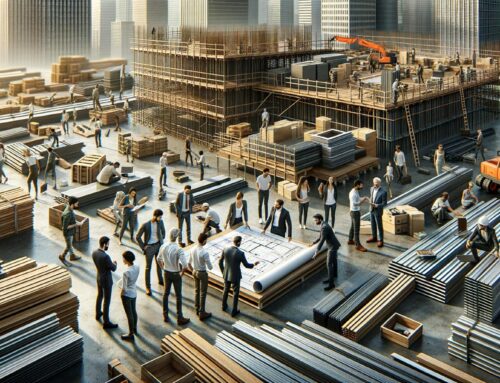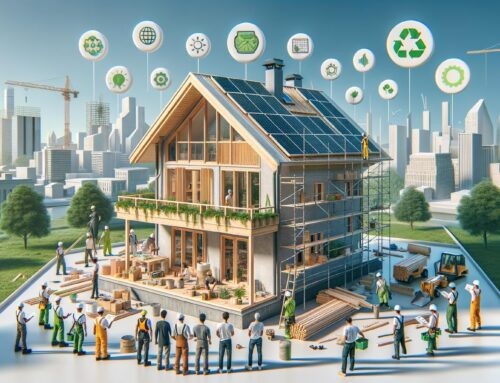
At Home Owners Association, we understand the growing importance of sustainable construction practices. Choosing ecologically friendly building materials is a key step in reducing environmental impact and creating healthier living spaces.
This guide will help you navigate the world of eco-friendly options, from understanding their characteristics to evaluating their long-term benefits. We’ll provide practical tips for selecting materials that align with both your environmental goals and budget constraints.
What Are Eco-Friendly Building Materials?
Definition and Importance
Eco-friendly building materials minimize environmental impact throughout their lifecycle. These products are typically renewable, recyclable, or made from recycled content. They also have lower embodied energy, which means their production and transportation require less energy.
Home Owners Association has noticed a significant increase in members seeking advice on sustainable construction. This trend reflects growing awareness of the environmental impact of traditional building practices.
Key Characteristics to Look For
When selecting eco-friendly building materials, consider these important features:
- Low toxicity: Materials should emit minimal volatile organic compounds (VOCs) to maintain good indoor air quality.
- Durability: Long-lasting materials reduce the need for frequent replacements, lowering overall resource consumption.
- Energy efficiency: Materials that provide good insulation can significantly reduce a home’s energy consumption.
- Local sourcing: Products sourced nearby reduce transportation emissions and support local economies.
- Recyclability: Materials that can be easily recycled at the end of their life cycle help minimize waste.
Common Sustainable Building Materials
Several eco-friendly options have gained popularity in recent years:
Bamboo: This fast-growing grass serves as an excellent alternative to hardwood. It’s renewable and has a high strength-to-weight ratio.
Recycled Steel: The use of recycled steel in construction can save energy.
Rammed Earth: This ancient technique uses compressed natural raw materials to create sturdy, well-insulated walls with minimal environmental impact.
Reclaimed Wood: The reuse of wood from old structures can reduce landfill waste.
Cork: Harvested from the bark of cork oak trees (without harming the tree), cork offers excellent insulation and sound absorption properties.
Low-VOC Paints: These paints can reduce indoor air pollution.
The selection of eco-friendly building materials marks a significant step towards sustainable construction. While initial costs may be higher, the long-term benefits for both homeowners and the environment are substantial. The next section will explore how to evaluate the environmental impact of these materials more thoroughly.
How to Measure Environmental Impact of Building Materials
Life Cycle Assessment: A Comprehensive Approach
Life Cycle Assessment (LCA) provides a thorough evaluation of building materials’ environmental impact from start to finish. This method examines all stages of a product’s life, including raw material extraction, manufacturing, transportation, use, and disposal.
Carbon Footprint: A Critical Factor
Carbon footprint measures the total greenhouse gas emissions associated with a product throughout its lifecycle. Selecting low-carbon materials can dramatically reduce this impact.
Certifications and Standards: Navigating Eco-Friendly Options
Several certifications and standards help identify truly sustainable options:
- Forest Stewardship Council (FSC) certification ensures wood products come from responsibly managed forests.
- Green Star certification (developed by the Green Building Council of Australia) rates the sustainability of buildings and communities.
- Global GreenTag assesses products based on health, eco-toxicity, and lifecycle analysis.
- GECA (Good Environmental Choice Australia) certification indicates products that meet rigorous environmental, health, and social impact criteria.
Home Owners Association recommends prioritizing these certifications when selecting materials. However, certifications shouldn’t be the only factor in your decision-making process. Consider the specific needs of your project and local environmental conditions as well.
Balancing Environmental Impact and Performance
While environmental impact is important, it’s essential to balance this with the material’s performance and suitability for your project. Some eco-friendly materials may require more maintenance or have shorter lifespans, potentially offsetting their initial environmental benefits.
Try to consider factors such as durability, energy efficiency, and local availability when evaluating materials. A material that lasts longer or provides better insulation may have a lower overall environmental impact, even if its initial production footprint is higher.
The next chapter will provide practical tips for selecting eco-friendly materials that align with both your environmental goals and project requirements.
How to Select Eco-Friendly Materials for Your Project
Research Local and Renewable Options
Start your search with materials available in your local area. Local sourcing cuts transportation emissions and bolsters your community’s economy. For example, if you reside in Tasmania, look into locally sourced timber from sustainably managed forests. The Tasmanian Timber website offers information on certified sustainable wood products in the region.
Consider renewable materials such as bamboo, hemp, and cork. Bamboo flooring sequesters up to 70% more carbon per acre and year than the average hardwood tree can, and over twice as much carbon per hectare per year.

Evaluate Cost and Environmental Benefits
Eco-friendly materials often have higher upfront costs but lead to long-term savings through energy efficiency and durability. A University of Melbourne study found that homes built with eco-friendly materials have 50% fewer airborne pollutants (potentially reducing health-related expenses over time).

Compare costs by considering the entire lifecycle of the material. Recycled steel might cost more initially, but its durability and recyclability at the end of its life can offset the higher price. The Steel Recycling Institute reports that using recycled steel saves enough energy to power 18 million households for a year.
Prioritize Durability and Performance
Select durable materials for long-term sustainability. Fiber cement siding is more durable than vinyl siding overall and has a longer life span. Reclaimed wood adds character to your project and reduces landfill waste by up to 8,000 pounds for a 2,000 square foot home (according to the National Association of Home Builders).

Consider the performance of materials in your specific climate. In Australia’s varied climate zones, materials with high thermal mass (like rammed earth or mud brick) can provide excellent insulation, reducing energy costs for heating and cooling.
Consider Certifications and Standards
Look for certifications that validate the eco-friendliness of materials:
- Forest Stewardship Council (FSC) certification ensures wood products come from responsibly managed forests.
- Green Star certification (developed by the Green Building Council of Australia) rates the sustainability of buildings and communities.
- Global GreenTag assesses products based on health, eco-toxicity, and lifecycle analysis.
- GECA (Good Environmental Choice Australia) certification indicates products that meet rigorous environmental, health, and social impact criteria.
These certifications help identify truly sustainable options, but don’t make them the sole factor in your decision-making process. Consider the specific needs of your project and local environmental conditions as well.
Balance Environmental Impact and Performance
While environmental impact matters, balance this with the material’s performance and suitability for your project. Some eco-friendly materials may require more maintenance or have shorter lifespans, potentially offsetting their initial environmental benefits.
Factor in durability, energy efficiency, and local availability when evaluating materials. A material that lasts longer or provides better insulation may have a lower overall environmental impact, even if its initial production footprint is higher.
Final Thoughts
Ecologically friendly building materials play a vital role in sustainable construction and healthier living environments. Homeowners who prioritize low toxicity, high durability, and energy efficiency in their material choices significantly reduce their environmental footprint. These sustainable options often lead to long-term cost savings through reduced utility bills and increased property values.
The selection of eco-friendly materials contributes to resource conservation, carbon emission reduction, and waste minimization. It also creates healthier indoor spaces with improved air quality, which benefits the well-being of occupants. Home Owners Association encourages you to consider sustainable options in your next home project, whether building new or renovating.
For more information and support in your sustainable building journey, visit Home Owners Association. Our team stands ready to help you make informed decisions that benefit both your home and the environment. Sustainable construction shapes a greener, healthier future for generations to come.





